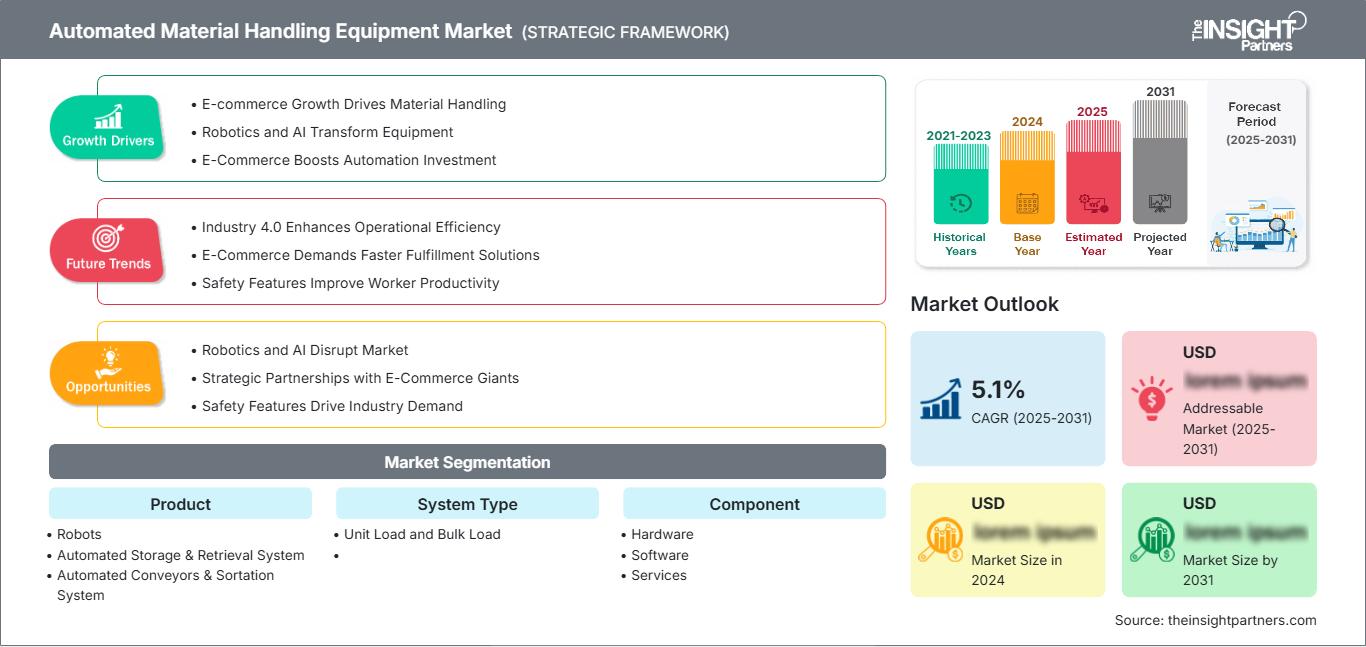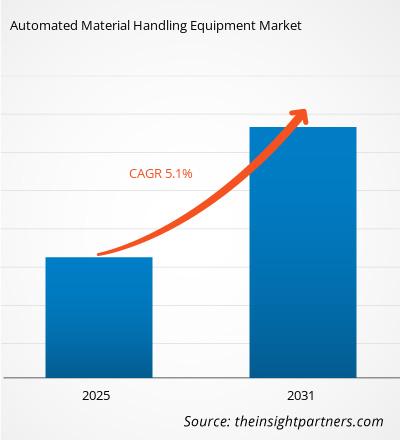Der Markt für automatisierte Materialhandhabungsgeräte wird voraussichtlich zwischen 2025 und 2031 eine durchschnittliche jährliche Wachstumsrate (CAGR) von 5,1 % verzeichnen, wobei das Marktvolumen von XX Millionen US-Dollar im Jahr 2024 auf XX Millionen US-Dollar im Jahr 2031 anwachsen wird.
Der Bericht zum Markt für automatisierte Materialhandhabungsgeräte umfasst Analysen nach Produkt, Systemtyp, Komponente, Funktion und Branche. Die globale Analyse wird weiter nach Regionen und wichtigen Ländern aufgeschlüsselt. Der Bericht bietet den Wert in US-Dollar für die oben genannte Analyse und Segmente.
Zweck des Berichts
Der Bericht „Markt für automatisierte Materialhandhabungsgeräte“ von The Insight Partners zielt darauf ab, die aktuelle Situation und das zukünftige Wachstum sowie die wichtigsten treibenden Faktoren, Herausforderungen und Chancen zu beschreiben. Dadurch erhalten verschiedene Geschäftsinteressenten Einblicke, beispielsweise:
- Technologieanbieter/-hersteller: Um die sich entwickelnde Marktdynamik zu verstehen und die potenziellen Wachstumschancen zu kennen, sodass sie fundierte strategische Entscheidungen treffen können.
- Investoren: Um eine umfassende Trendanalyse hinsichtlich der Marktwachstumsrate, der finanziellen Marktprognosen und der Chancen entlang der Wertschöpfungskette durchzuführen.
- Regulierungsbehörden: Um Richtlinien und Überwachungsaktivitäten auf dem Markt zu regulieren, mit dem Ziel, Missbrauch zu minimieren, das Vertrauen der Investoren zu wahren und die Integrität und Stabilität des Marktes aufrechtzuerhalten.
Automatisierte Materialtransportgeräte Marktsegmentierung Produkt
- Roboter
- Automatisiertes Lager- und Bereitstellungssystem
- Automatisierte Förder- und Sortiersysteme
- Automatisierte Kräne
- Fahrerlose Transportfahrzeuge
Systemtyp
- Einheitsladung und Schüttgut Laden
Komponente
- Hardware
- Software
- Dienstleistungen
Funktion
- Lagerung
- Transport
- Montage
- Verpackung
- Verteilung
- Abfallbehandlung
Industrie
- Automobil
- Elektronik
- Lebensmittel & Getränke
- E-Commerce
- Luft- und Raumfahrt
- Logistik
- Pharmazeutika
Sie erhalten kostenlos Anpassungen an jedem Bericht, einschließlich Teilen dieses Berichts oder einer Analyse auf Länderebene, eines Excel-Datenpakets sowie tolle Angebote und Rabatte für Start-ups und Universitäten.
Markt für automatisierte Materialhandhabungsgeräte: Strategische Einblicke

-
Holen Sie sich die wichtigsten Markttrends aus diesem Bericht.Dieses KOSTENLOSE Beispiel umfasst Datenanalysen, die von Markttrends bis hin zu Schätzungen und Prognosen reichen.
Wachstumstreiber für automatisierte Materialhandhabungsgeräte
- E-Commerce-Wachstum treibt Materialhandhabung voran: Die stetig wachsende Nachfrage nach effektiver Materialhandhabung in Lagern ist die treibende Kraft. Aufgrund des weltweit zunehmenden E-Commerce setzen Unternehmen auf Automatisierung, um große Bestellmengen abzuwickeln. Dieser Trend zur Automatisierung treibt das Marktwachstum dieser Technologie maßgeblich voran, da Unternehmen versuchen, ihre Lieferkette zu optimieren und alle möglichen Einsparungen bei den Betriebskosten zu erzielen, wie aktuelle Marktanalysen zeigen.
- Robotik und KI transformieren Ausrüstung: Globale Materialhandhabungsgeräte werden durch die Integration von Robotik und künstlicher Intelligenz transformiert. Diese Fortschritte prägen Markttrends und fördern die Nachfrage nach deutlich effizienteren Abläufen, auf die sich die Industrie zubewegt.
- E-Commerce fördert Investitionen in Automatisierung: Der rasante Aufstieg der E-Commerce-Branche hat den Markt für automatisierte Materialhandhabungsgeräte stark beeinflusst. Da immer mehr Bestellungen online aufgegeben werden, investieren Unternehmen in Automatisierungssysteme, um die Nachfrage zügig zu erfüllen. Aktuelle Marktberichte zeigen, dass Akteure auf dem Weltmarkt ihre Investitionen in Automatisierungslösungen für Logistik und Lagerhaltung bisher um 15 % erhöht haben. Dies verändert die Größe des Marktes und generiert Wachstum in wichtigen Regionen weltweit.
Markttrends für automatisierte Materialhandhabungsgeräte – Zukunftstrends
- Industrie 4.0 verbessert Betriebseffizienz: Industrie 4.0-Technologien wie IoT und Big Data Analytics verändern AMHE insofern, als dass vorausschauende Wartung und Betriebseffizienz mithilfe dieser Technologien optimiert werden. Eine Umfrage aus dem Jahr 2022 zeigte, dass mehr als 50 % der Unternehmen, die AMHE nutzen, eine bessere Lieferkette bestätigten, indem sie ihre Entscheidungen auf Datenbasis trafen. In einer solchen Marktdynamik befinden sich Unternehmen am Beginn einer Ära, in der sie den Ressourcenverbrauch optimieren und Ausfallzeiten minimieren können.
- E-Commerce erfordert schnellere Fulfillment-Lösungen: E-Commerce ist ein schnell wachsender Markt und wächst weiter, was Innovationen in AMHE vorantreibt, insbesondere für die letzte Meile. Marktstrategien konzentrieren sich auf Effizienz und Geschwindigkeit in Fulfillment-Zentren. Einer aktuellen Studie zufolge haben sich bereits über 60 % der Logistikunternehmen in AMHE integriert, um ihre Lieferketten zu optimieren. Eine PEST-Analyse zeigt, dass die Veränderung des Verbraucherverhaltens hin zum Online-Shopping die Unternehmen dazu gezwungen hat, in fortschrittliche Handhabungslösungen zu investieren. Dieser Trend macht AMHE zu einer Notwendigkeit, um die wachsenden Erwartungen der Verbraucher zu erfüllen.
- Sicherheitsfunktionen verbessern die Produktivität der Mitarbeiter: Angesichts der zunehmenden Sicherheitsprobleme in Lagern wird ergonomisches Design im Bereich AMHE immer wichtiger. Führende Unternehmen entwickeln Geräte, die Stress und Unfälle bei den Mitarbeitern reduzieren. Einer aktuellen Umfrage zufolge haben schätzungsweise 70 % der Unternehmen, die Sicherheitsmaßnahmen umgesetzt haben, die Zahl der Arbeitsunfälle stark reduziert. Eine weitere Marktdynamik spiegelt deutlich wider, wie diese Sicherheitsaspekte den Vorschriften entsprechen und die Produktivität der Mitarbeiter steigern. SWOT-Analysen zeigen, dass die Betonung der Ergonomie einen Wettbewerbsvorteil verschaffen kann.
Marktchancen für automatisierte Materialhandhabungsgeräte
- Robotik und KI revolutionieren den Markt: Fortschritte in der Robotik und KI-gesteuerten Technologien revolutionieren den Markt für automatisierte Materialhandhabungsgeräte, insbesondere in Europa und Asien. Wettbewerbsanalysen zeigen, dass führende Unternehmen in Forschung und Entwicklung einen beträchtlichen Marktanteil haben. Unternehmen, die diese technologischen Entwicklungen nutzen, können weltweit Kosten sparen, die Sicherheit verbessern und sich Wettbewerbsvorteile sichern.
- Strategische Partnerschaften mit E-Commerce-Giganten: Strategische Partnerschaften mit den größten E-Commerce-Websites sind eine weitere enorme Wachstumschance im Markt für automatisierte Materialhandhabungsgeräte. Da der Online-Handel voraussichtlich weiter wachsen wird, freuen sich Logistikunternehmen auf einen höheren Automatisierungsgrad in ihrem Geschäft. Wettbewerbsanalysen deuten darauf hin, dass Automatisierungspartnerschaften mit E-Commerce-Giganten dies ebenfalls in Bezug auf Effizienz und Geschwindigkeit ermöglichen werden. Dieser Trend verändert das Gesicht der Branche und ermöglicht es Unternehmen, Technologien besser einzusetzen, um auf die sich ändernden Bedürfnisse und Wünsche der Verbraucher in verschiedenen geografischen Gebieten zu reagieren.
- Sicherheitsfunktionen treiben die Nachfrage der Branche: Aus arbeitstechnischer Sicht ist Sicherheit im Hinblick auf die Automatisierung des Materialtransports stets ein wichtiges Thema und hat in der Branche höchste Priorität, was die Nachfrage nach verbesserten Sicherheitsfunktionen weiter anheizt. Neuen Statistiken zufolge reduzieren Unternehmen, die in automatisierte Sicherheitsausrüstung, einschließlich Kollisionsvermeidungssysteme, investieren, die Zahl der Arbeitsunfälle um 25 %. Wettbewerbsanalysen zeigen, dass Unternehmen, die sich auf Sicherheit konzentrieren, nicht nur die Sicherheit ihrer Mitarbeiter schützen, sondern auch ihre Betriebseffizienz verbessern. Die Betonung der Sicherheit schafft ein gutes Branchenklima für Wachstum, insbesondere in hochgefährlichen Umgebungen wie Lagerhallen oder Produktionsanlagen.
Regionale Einblicke in den Markt für automatisierte Materialhandhabungsgeräte
Die Analysten von The Insight Partners haben die regionalen Trends und Faktoren, die den Markt für automatisierte Materialtransportgeräte im Prognosezeitraum beeinflussen, ausführlich erläutert. In diesem Abschnitt werden auch die Marktsegmente und die geografische Verteilung automatisierter Materialtransportgeräte in Nordamerika, Europa, im asiatisch-pazifischen Raum, im Nahen Osten und Afrika sowie in Süd- und Mittelamerika erörtert.
Umfang des Marktberichts über automatisierte Materialhandhabungsgeräte
| Berichtsattribut | Einzelheiten |
|---|---|
| Marktgröße in 2024 | US$ XX million |
| Marktgröße nach 2031 | US$ XX Million |
| Globale CAGR (2025 - 2031) | 5.1% |
| Historische Daten | 2021-2023 |
| Prognosezeitraum | 2025-2031 |
| Abgedeckte Segmente |
By Produkt
|
| Abgedeckte Regionen und Länder |
Nordamerika
|
| Marktführer und wichtige Unternehmensprofile |
|
Marktdichte der Akteure im Bereich automatisierter Materialtransportgeräte: Auswirkungen auf die Geschäftsdynamik verstehen
Der Markt für automatisierte Materialtransportsysteme wächst rasant. Die steigende Nachfrage der Endverbraucher ist auf Faktoren wie veränderte Verbraucherpräferenzen, technologische Fortschritte und ein stärkeres Bewusstsein für die Produktvorteile zurückzuführen. Mit der steigenden Nachfrage erweitern Unternehmen ihr Angebot, entwickeln Innovationen, um den Bedürfnissen der Verbraucher gerecht zu werden, und nutzen neue Trends, was das Marktwachstum weiter ankurbelt.

- Holen Sie sich die Markt für automatisierte Materialhandhabungsgeräte Übersicht der wichtigsten Akteure
Wichtige Verkaufsargumente
- Umfassende Abdeckung: Der Bericht analysiert umfassend Produkte, Dienstleistungen, Typen und Endnutzer des Marktes für automatisierte Materialhandhabungsgeräte und bietet einen ganzheitlichen Überblick.
- Expertenanalyse: Der Bericht basiert auf dem umfassenden Verständnis von Branchenexperten und Analysten.
- Aktuelle Informationen: Der Bericht gewährleistet Geschäftsrelevanz durch die Berichterstattung über aktuelle Informationen und Datentrends.
- Anpassungsoptionen: Dieser Bericht kann an spezifische Kundenanforderungen angepasst werden und passt sich optimal an die Geschäftsstrategien an.
Der Forschungsbericht zum Markt für automatisierte Materialhandhabungsgeräte kann daher dazu beitragen, die Branchensituation und die Wachstumsaussichten zu entschlüsseln und zu verstehen. Obwohl es einige berechtigte Bedenken geben kann, überwiegen die Vorteile dieses Berichts tendenziell die Nachteile.
- Historische Analyse (2 Jahre), Basisjahr, Prognose (7 Jahre) mit CAGR
- PEST- und SWOT-Analyse
- Marktgröße Wert/Volumen – Global, Regional, Land
- Branchen- und Wettbewerbslandschaft
- Excel-Datensatz
Aktuelle Berichte
Erfahrungsberichte
Grund zum Kauf
- Fundierte Entscheidungsfindung
- Marktdynamik verstehen
- Wettbewerbsanalyse
- Kundeneinblicke
- Marktprognosen
- Risikominimierung
- Strategische Planung
- Investitionsbegründung
- Identifizierung neuer Märkte
- Verbesserung von Marketingstrategien
- Steigerung der Betriebseffizienz
- Anpassung an regulatorische Trends






















 Kostenlose Probe anfordern für - Markt für automatisierte Materialhandhabungsgeräte
Kostenlose Probe anfordern für - Markt für automatisierte Materialhandhabungsgeräte